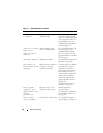
50 Using the System Setup Program
Memory Information Displays a screen to view memory information and to
configure certain memory features. See Table 2-3.
CPU Information Displays information related to microprocessors (speed,
cache size, and so on). See Table 2-4.
Boot Sequence Determines the order in which the system searches for
boot devices during system startup. Available options can
include the diskette drive, CD drive, hard drives, and
network. If you have installed a RAC, additional options
such as virtual floppy and virtual CD-ROM may be
present.
NOTE: System boot is not supported from an external device
attached to a SAS or SCSI adapter. See support.dell.com for
the latest support information about booting from external
devices
Hard-Disk Drive
Sequence
Determines the order in which the system searches the
hard drives during system startup. The selections depend
on the hard drives installed in your system.
USB Flash Drive
Emulation Type
(Auto default)
Determines the emulation type for a USB flash drive. Hard
disk allows the USB flash drive to act as a hard drive.
Floppy allows the USB flash drive to act as a removal
diskette drive. Auto automatically chooses an emulation
type.
Boot Sequence Retry
(Disabled default)
Enables or disables the Boot Sequence Retry feature.
When set to Enabled, the system re-attempts the boot
sequence after a 30-second timeout if the previous boot
attempt failed.
Integrated Devices Displays a screen to configure the system’s integrated
devices.
PCI IRQ Assignment Displays a screen to change the IRQ assigned to each of
the integrated devices on the PCI bus, and any installed
expansion cards that require an IRQ.
Serial Communication Displays a screen to configure serial communication,
external serial connector, fail-safe baud rate, remote
terminal type, and redirection after boot.
Table 2-2. System Setup Program Options (continued)
Option Description


















